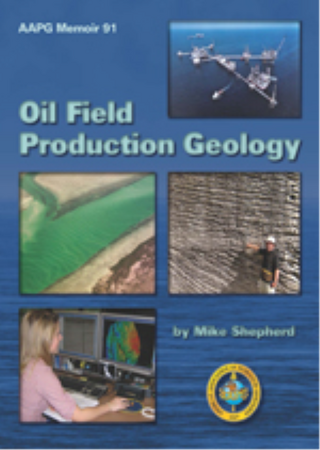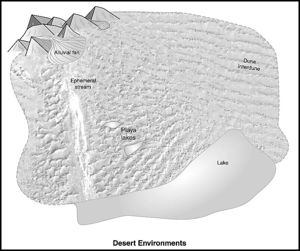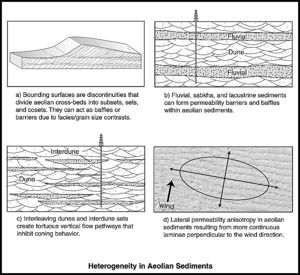Difference between revisions of "Eolian reservoirs"
(Created page with "'''This page is under development''' {{publication | image = Oil-field-production-geology.png | series = Memoirs | title = Oil Field Production Geology | part =...") |
|||
| Line 29: | Line 29: | ||
Interdune and fluvial sediments generally show poorer reservoir characteristics by comparison to dune lithofacies. They are poorly sorted and are more likely to contain evaporite cements. Intercalated fine-grained sand and silt laminations together with diagenetic cementation tend to produce reservoir intervals with very poor vertical permeability. Nagtegaal<ref name=Nagtegaal_1979 /> used multivariate analysis to determine the factors controlling the porosity of eolian sediments from the Permian of the southern North Sea. He found that the main control on porosity is grain sorting, which varies from well sorted in dune sandstones to less well sorted in the other associated sediments. The relationship between original sedimentary texture and porosity has survived even after extensive diagenesis. The very poor permeability characteristics of interdune sediments are commonly reported. Lindquist<ref name=Lindquist_1983 /> found a contrast in permeability of four to five orders of magnitude between interdune and dune deposits in the Nugget Sandstone of southwestern Wyoming. | Interdune and fluvial sediments generally show poorer reservoir characteristics by comparison to dune lithofacies. They are poorly sorted and are more likely to contain evaporite cements. Intercalated fine-grained sand and silt laminations together with diagenetic cementation tend to produce reservoir intervals with very poor vertical permeability. Nagtegaal<ref name=Nagtegaal_1979 /> used multivariate analysis to determine the factors controlling the porosity of eolian sediments from the Permian of the southern North Sea. He found that the main control on porosity is grain sorting, which varies from well sorted in dune sandstones to less well sorted in the other associated sediments. The relationship between original sedimentary texture and porosity has survived even after extensive diagenesis. The very poor permeability characteristics of interdune sediments are commonly reported. Lindquist<ref name=Lindquist_1983 /> found a contrast in permeability of four to five orders of magnitude between interdune and dune deposits in the Nugget Sandstone of southwestern Wyoming. | ||
| + | ==Geometry== | ||
| + | Eolian sediments form layer-cake to jigsaw-puzzle geometries. Dune sand bodies may intercalate with or pinch out into poorer quality sabkha and fluvial facies associations. Eolian environments tend to occur on a large scale and dune sandstones can be greater in length than typical well spacings. Weber<ref name=Weber_1987 /> described outcrops of eolian sandstone in the Permian De Chelly Sandstone in northern Arizona. The average thickness of cross-bed sets is about 6 m (20 ft). The width-to-thickness ratio is estimated as between 50:1 and 100:1. The length-to-thickness ratio is estimated as 200 to 1. | ||
| + | ==Heterogeneity of eolian sandstones== | ||
| + | It is difficult to make generalizations about the effect of heterogeneity on hydrocarbon recovery from eolian sandstones as recovery factors seem to vary enormously worldwide. It is possible that eolian sandstones are much better suited as gas than oil reservoirs. Some of the Western European Permian desert sandstone gas reservoirs show very high recoveries; a 91% recovery factor is quoted for the Leman gas field for instance.<ref name=Hillier_2003 /> By comparison, the viscous oil reservoirs of the Pennsylvanian to Permian Tensleep Sandstone of Wyoming and Montana show low recoveries by primary production. In the Little Buffalo Basin field of Wyoming, well spacing has been reduced successively from 40- to 20- to 10- to 5-ac spacing, in some cases without interwell interference.<ref name=Mccaleb_1979 /><ref name=Ahlbrandtandfryberger_1982 /> | ||
| + | |||
| + | [[File:M91FG171.JPG|thumb|300px|{{figure number|2}}The influence on fluid flow by heterogeneity in eolian sediments.]] | ||
| + | |||
| + | Ciftci et al.<ref name=Ciftcietal_2004 /> attributed the poor recovery in the Tensleep Sandstone to low permeability baffles and barriers along bounding surfaces within the eolian dune sets. Bounding surfaces are subhorizontal to inclined discontinuities that divide eolian cross-beds into subsets, sets, and cosets ([[:file:M91FG171.JPG|Figure 2a]]). These form as a result of dune migration at the smaller scale and from regional discontinuities at the larger scale. Bounding surfaces have a tendency to act as baffles or barriers as a result of facies and grain size contrasts across them.<ref name=Shebi_1995 /> Perhaps the considerable difference in recoveries between the eolian reservoirs of Northwestern Europe and the United States is a function of how bounding surfaces influence fluid flow in each area. These features may provide less of an impedance to the flow of highly mobile gas in the Northwestern Europe gas fields than they do for the viscous oil found in the Tensleep Sandstone of Wyoming and Montana. | ||
| + | |||
| + | One other factor may contribute to poorer oil than gas recoveries in eolian sediments. In oil fields, a significant volume of capillary-trapped oil can result from the waterflooding of dune-bedded sandstones. Huang et al.<ref name=Huangetal_1995 /> showed that between 30 and 55% of the oil was trapped in a coreflood experiment on cross-laminated eolian sandstone under conditions of low-rate flooding. | ||
| + | |||
| + | ==Vertical permeability barriers in eolian sandstones== | ||
Revision as of 17:21, 29 July 2015
This page is under development
| Oil Field Production Geology | |

| |
| Series | Memoirs |
|---|---|
| Part | The Production Geologist and the Reservoir |
| Chapter | Eolian reservoirs |
| Author | Mike Shepherd |
| Link | Web page |
| PDF file (requires access) | |
| Store | AAPG Store |
Eolian sediments comprise desert sediments and coastal sand dunes, much of which are wind deposited. They can form thick and laterally extensive sandstone reservoirs. Eolian sandstone reservoirs are commonly found in two time intervals in the geological record, the early Paleozoic and between the Permian and the Early Jurassic.[1]
Eolian lithofacies associations
Eolian lithofacies associations include dune, interdune, fluvial, and sabkha environments (Figure 1). Dunes form where large volumes of dry sand are blown across the landscape. Lying between the dunes are the interdune areas, which are flat-lying belts or depressions. These areas may be subjected to either erosion or deposition. In wetter conditions, alluvial fans may extend outwards from upland areas, and fluvial sediments can be deposited by ephemeral streams. Large damp to wet areas between the dunes may dry out to form flat-lying evaporitic crusts called sabkhas. Playa lakes are desert lakes that episodically dry out.
Several different dune types are found in deserts. They can form as crescentic dunes (including barchan dunes), as long linear dunes, or as star dunes with crest lines radiating from one or two central peaks. Different dune types may be superimposed to form complex dunes, whereas the same type of dune is superimposed to form compound dunes. The term draa has been used to refer to large compound or complex dunes.[2]
In deserts, dune sediments aggrade laterally and vertically as large-scale sand blankets. These may be very thick (more than 300 m [1000 ft]), and cover hundreds of square kilometers.[3] Internally, dunes comprise thick, cross-bedded intervals of well-rounded, well-sorted sandstones. They are normally the most productive lithofacies in eolian reservoir systems. Flatter-lying eolian sand sheets may be found along the margins of dune systems.[4]
Interdune and fluvial sediments generally show poorer reservoir characteristics by comparison to dune lithofacies. They are poorly sorted and are more likely to contain evaporite cements. Intercalated fine-grained sand and silt laminations together with diagenetic cementation tend to produce reservoir intervals with very poor vertical permeability. Nagtegaal[5] used multivariate analysis to determine the factors controlling the porosity of eolian sediments from the Permian of the southern North Sea. He found that the main control on porosity is grain sorting, which varies from well sorted in dune sandstones to less well sorted in the other associated sediments. The relationship between original sedimentary texture and porosity has survived even after extensive diagenesis. The very poor permeability characteristics of interdune sediments are commonly reported. Lindquist[6] found a contrast in permeability of four to five orders of magnitude between interdune and dune deposits in the Nugget Sandstone of southwestern Wyoming.
Geometry
Eolian sediments form layer-cake to jigsaw-puzzle geometries. Dune sand bodies may intercalate with or pinch out into poorer quality sabkha and fluvial facies associations. Eolian environments tend to occur on a large scale and dune sandstones can be greater in length than typical well spacings. Weber[7] described outcrops of eolian sandstone in the Permian De Chelly Sandstone in northern Arizona. The average thickness of cross-bed sets is about 6 m (20 ft). The width-to-thickness ratio is estimated as between 50:1 and 100:1. The length-to-thickness ratio is estimated as 200 to 1.
Heterogeneity of eolian sandstones
It is difficult to make generalizations about the effect of heterogeneity on hydrocarbon recovery from eolian sandstones as recovery factors seem to vary enormously worldwide. It is possible that eolian sandstones are much better suited as gas than oil reservoirs. Some of the Western European Permian desert sandstone gas reservoirs show very high recoveries; a 91% recovery factor is quoted for the Leman gas field for instance.[8] By comparison, the viscous oil reservoirs of the Pennsylvanian to Permian Tensleep Sandstone of Wyoming and Montana show low recoveries by primary production. In the Little Buffalo Basin field of Wyoming, well spacing has been reduced successively from 40- to 20- to 10- to 5-ac spacing, in some cases without interwell interference.[9][10]
Ciftci et al.[11] attributed the poor recovery in the Tensleep Sandstone to low permeability baffles and barriers along bounding surfaces within the eolian dune sets. Bounding surfaces are subhorizontal to inclined discontinuities that divide eolian cross-beds into subsets, sets, and cosets (Figure 2a). These form as a result of dune migration at the smaller scale and from regional discontinuities at the larger scale. Bounding surfaces have a tendency to act as baffles or barriers as a result of facies and grain size contrasts across them.[12] Perhaps the considerable difference in recoveries between the eolian reservoirs of Northwestern Europe and the United States is a function of how bounding surfaces influence fluid flow in each area. These features may provide less of an impedance to the flow of highly mobile gas in the Northwestern Europe gas fields than they do for the viscous oil found in the Tensleep Sandstone of Wyoming and Montana.
One other factor may contribute to poorer oil than gas recoveries in eolian sediments. In oil fields, a significant volume of capillary-trapped oil can result from the waterflooding of dune-bedded sandstones. Huang et al.[13] showed that between 30 and 55% of the oil was trapped in a coreflood experiment on cross-laminated eolian sandstone under conditions of low-rate flooding.
Vertical permeability barriers in eolian sandstones
See also
- [[
- [[
- [[
References
- ↑ Cite error: Invalid
<ref>tag; no text was provided for refs namedNorth_1985 - ↑ Cite error: Invalid
<ref>tag; no text was provided for refs namedKocurek_1996 - ↑ Cite error: Invalid
<ref>tag; no text was provided for refs namedRichardsonetal_1988a - ↑ Cite error: Invalid
<ref>tag; no text was provided for refs namedKocurekandnielson_1986 - ↑ Cite error: Invalid
<ref>tag; no text was provided for refs namedNagtegaal_1979 - ↑ Cite error: Invalid
<ref>tag; no text was provided for refs namedLindquist_1983 - ↑ Cite error: Invalid
<ref>tag; no text was provided for refs namedWeber_1987 - ↑ Cite error: Invalid
<ref>tag; no text was provided for refs namedHillier_2003 - ↑ Cite error: Invalid
<ref>tag; no text was provided for refs namedMccaleb_1979 - ↑ Cite error: Invalid
<ref>tag; no text was provided for refs namedAhlbrandtandfryberger_1982 - ↑ Cite error: Invalid
<ref>tag; no text was provided for refs namedCiftcietal_2004 - ↑ Cite error: Invalid
<ref>tag; no text was provided for refs namedShebi_1995 - ↑ Cite error: Invalid
<ref>tag; no text was provided for refs namedHuangetal_1995

